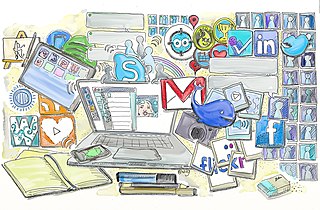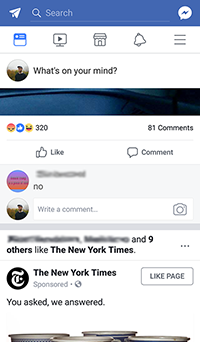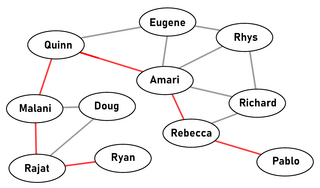
Friendster was a social network based in Mountain View, California, founded by Jonathan Abrams and launched in March 2003. Later, the company became a social gaming site based in Kuala Lumpur, Malaysia. Before Friendster was redesigned, the service allowed users to contact other members, maintain those contacts, and share online content and media with those contacts. The website was also used for dating and discovering new events, bands and hobbies. Users could share videos, photos, messages, and comments with other members via profiles and networks. It is considered one of the original social networks.
The social web is a set of social relations that link people through the World Wide Web. The social web encompasses how websites and software are designed and developed in order to support and foster social interaction. These online social interactions form the basis of much online activity including online shopping, education, gaming and social networking services. The social aspect of Web 2.0 communication has been to facilitate interaction between people with similar tastes. These tastes vary depending on who the target audience is, and what they are looking for. For individuals working in the public relation department, the job is consistently changing and the impact is coming from the social web. The influence held by the social network is large and ever changing.

A social networking service or SNS is a type of online social media platform which people use to build social networks or social relationships with other people who share similar personal or career content, interests, activities, backgrounds or real-life connections.

Meebo was an instant messaging and social networking service provider. It was founded in September 2005 by Sandy Jen, Seth Sternberg, and Elaine Wherry, and was based in Mountain View, California. Initially the company offered a web-based instant messenger service, extending its offer in more general online chat and even social networking directions. In June 2012, Google acquired Meebo to merge the company's staff with the Google+ developers team.
The eCRUSH network consisted of two sites: eCRUSH.com and eSPIN.com. The network was acquired by Hearst Media on December 31, 2006. The original eCRUSH site was opened on February 14, 1999 in Chicago by Clark Benson and Karen DeMars Pillsbury. It pre-dated social networking sites such as Friendster, MySpace and Facebook.

classmates.com is a social networking service. It was founded on November 17, 1995 by Randy Conrads as Classmates Online, Inc. and headquartered in Bellevue, Washington. It currently is the leading online social network service in the United States for bringing high school alumni together with over 90 million members. Classmates also offers the largest library of digitized yearbooks available anywhere on the Internet, with over 470,000 yearbooks available online.
RapLeaf was a US-based marketing data and software company that was acquired by email data provider TowerData in 2013.

Facebook is a social media and social networking service owned by the American technology conglomerate Meta. Created in 2004 by Mark Zuckerberg with four other Harvard College students and roommates Eduardo Saverin, Andrew McCollum, Dustin Moskovitz, and Chris Hughes, its name derives from the face book directories often given to American university students. Membership was initially limited to Harvard students, gradually expanding to other North American universities. Since 2006, Facebook allows everyone to register from 13 years old, except in the case of a handful of nations, where the age limit is 14 years. As of December 2022, Facebook claimed almost 3 billion monthly active users. As of October 2023, Facebook ranked as the 3rd most visited website in the world, with 22.56% of its traffic coming from the United States. It was the most downloaded mobile app of the 2010s.

Mobile social networking is social networking where individuals with similar interests converse and connect with one another through their mobile phone and/or tablet. Much like web-based social networking, mobile social networking occurs in virtual communities.

Tagged is a social discovery website based in San Francisco, California, founded in 2004. It allows members to browse the profiles of any other members, and share tags and virtual gifts. Tagged claims it has 300 million members as of 2014. As of September 2011, Quantcast estimates Tagged monthly unique users at 5.9 million in the United States, and 18.6 million globally. Michael Arrington wrote in April 2011 that Tagged is most notable for the ability to grow profitably during the era of Facebook.
The Facebook Platform is the set of services, tools, and products provided by the social networking service Facebook for third-party developers to create their own applications and services that access data in Facebook.

The Renren Network, formerly known as the Xiaonei Network, is a Chinese social networking service similar to Facebook. It was popular among college students. Renren Inc. has its headquarters in Chaoyang District, Beijing, with additional offices in Shanghai and Guangzhou. Renren had an $740m initial public offering (IPO) on the New York Stock Exchange in April 2011.
Sonico was a free-access social networking service oriented toward a Latin American audience.

Social media marketing is the use of social media platforms and websites to promote a product or service. Although the terms e-marketing and digital marketing are still dominant in academia, social media marketing is becoming more popular for both practitioners and researchers.

Path was a social networking-enabled photo sharing and messaging service for mobile devices that was launched on 14 November 2010. The service allowed users to share up to a total of 50 contacts with their close friends and family. Based in San Francisco, California, the company was founded by Shawn Fanning and former Facebook executive Dave Morin.
Since the arrival of early social networking sites in the early 2000s, online social networking platforms have expanded exponentially, with the biggest names in social media in the mid-2010s being Facebook, Instagram, Twitter and Snapchat. The massive influx of personal information that has become available online and stored in the cloud has put user privacy at the forefront of discussion regarding the database's ability to safely store such personal information. The extent to which users and social media platform administrators can access user profiles has become a new topic of ethical consideration, and the legality, awareness, and boundaries of subsequent privacy violations are critical concerns in advance of the technological age.
Zorpia is a social networking service with customers in China. Zorpia is one of the few international social networks with a Chinese Internet Content Provider license. The social networking site reports 2 million unique users per month and a total worldwide user base of 26 million. Jeffrey Ng is the company's founder and CEO of Zorpia. The privately funded company is based in Hong Kong and has 30 employees.

Six degrees of separation is the idea that all people are six or fewer social connections away from each other. As a result, a chain of "friend of a friend" statements can be made to connect any two people in a maximum of six steps. It is also known as the six handshakes rule.
The advent of social networking services has led to many issues spanning from misinformation and disinformation to privacy concerns related to public and private personal data.
Comparison of user features of messaging platforms refers to a comparison of all the various user features of various electronic instant messaging platforms. This includes a wide variety of resources; it includes standalone apps, platforms within websites, computer software, and various internal functions available on specific devices, such as iMessage for iPhones.











